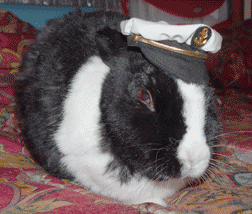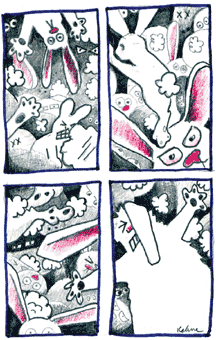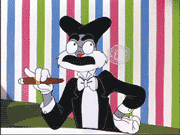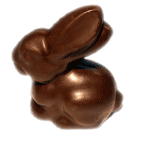|
|||||||||
|
One of How a Rabbit Changed My Lifeby Alice SnivelyEditor’s note: This story is excerpted from The Book of Ferd, an exploration of and inquiry into the nature of animal consciousness via the vehicle of the life of one small rabbit. It is not a Peter the Rabbit tale for the very young.The rabbit came into our lives more than eight years ago, at a time when we were happy empty-nesters with no desire for a pet. But something in his eyes, his demeanor, compelled me to agree to bring him home. Before the day was over, my husband Hugh felt it too, and the fates of one not-quite-grown, black-and-white, Dutch rabbit were joined with ours. This animal had so much charisma, was so self-assured, that we named him Ferdinand-the-Bull-Rabbit. We called him Ferd. Back then, we lived on land in a conventional home. I don’t like confining pets unless it’s absolutely necessary, so I kept his cage open for him to do his business in. He got it right away, so I bought him a proper litter box and got rid of the cage. If only my children had been so easy to potty train. The Great CommunicatorI’d had rabbits before, but none as gregarious as this one. He loved being with us, doing things with us. Most animals want to be fed at the same times every day. It took a while for me to understand that he wanted his dinner when we had ours, even though our dinner hours were irregular. When we opened the mail, he wanted to help, so he got the junk mail. If we were reading, he wanted to read, so we kept old catalogs and such for his library. Ferd was an extraordinary communicator. Dogs and cats can vocalize, but rabbits generally remain mute except in extreme terror, when they scream. Our little man had numerous ways of making his points. His eyes were very expressive, and when you got the Ferd stare, you knew he was displeased. His ears, of course, were also very expressive. When they were erect and tilted slightly outward, that meant he was alert and things were normal. When he was extremely happy, little kinks would appear in the tips of his ears. When he wanted to play, he’d thrust his kinked ears forward and shoot a look of joyful challenge. He loved to tease and be teased. If he wanted attention, he’d come and gently bump against me or Hugh, and he sometimes did this just to let us know he was nearby and happy. True to rabbit nature, of course, he loved running, jumping and performing mid-air twirls. His speed was breathtaking. With encouragement from us, he’d redouble his stunts. Then he began to talk; more on that later. Adolescence was a difficult time for Ferd. He fell in love with a long-handled duster that I had hung on a chair and tried making love to it. His frustration was sad to watch; he knew this was not another rabbit, but his hormones were in charge. This along with his need to mark territory led us to have him neutered, which took care of his sex drive, but didn’t otherwise alter his personality. He continued to mature into a fine companion.
Becoming A Boat BunnyA year after Ferd became part of our family, we sold our home and moved aboard a boat on Chesapeake Bay. In the beginning, we leased a houseboat to confirm our decision to live on the water. We didn’t know how Ferd would adapt, since bunnies, like cats, aren’t keen on being in water. The boat had a large foredeck, protected so he couldn’t fall overboard, that provided plenty of play space, and he soon seemed quite content with his new environment. The gentle rocking motion of the boat didn’t bother him at all. Once when we got caught in a pop-up storm on a cruise, we took a couple of large waves that flooded the foredeck and sent him and his special outdoor rabbit hutch afloat for a few minutes. He never showed signs of fear or panic, but he sure did shoot the captain a look of intense disgust, laying his ears back flat, and erecting his mohawk, a tuft of fur that puffed up between his ears when he was displeased. After searching for two and a half years, we found the right sailboat for our needs. This move drastically altered Ferd’s surroundings. No more big protected foredeck, and more in-port motion. Ferd wasted no time figuring out the lay of the deck and the interior cabin and instructing us on how he wanted to settle in. We had a hard dinghy placed upside down on the foredeck above the v-berth area of the cabin. That was his burrow. He slept under it and from that position could watch action and people on the dock without being seen. His food and litter box he wanted in the cockpit near the cabin doors. This put him close to us for meal time and let him spend time with us outside. In good weather, we kept the cabin doors open so he could come inside when he wanted. He studied the boundaries of the deck, knew how to judge his running distances, and never fell overboard despite lots of high-velocity bounding. Once again, even when the boat was rocking in the wind, he seemed unbothered. We wondered how he would take to sailing, a very different movement from the relatively smooth and level travel of the houseboat. When we prepared to take our first cruise, it wasn’t safe for him to remain up front under the dinghy; a wave could wash him overboard. We put him in the pet carrier where he often lounged, told him it was his sea station and kept the door latched until we were underway. He seemed to understand, and after a time, if we were going out and told him to take up his sea station, he usually went voluntarily. He did well when we heeled; he’d shift his position just like people do to compensate for the angle. Ferd was a great sailor. One Smart RabbitIn all the pets I’ve had over the years, I never encountered one with so much innate intelligence. Ferd understood language better than any dog or cat I’ve known. And he knew how to plan, to adapt to changing conditions better than some people. A prime example was his adaptation to his winter bungalow. When winter came, we decided to give him another layer of shelter under the dinghy. Ferd loved to chew on cardboard, and we would occasionally give him a box to play with. We’d cut a door for him and then he’d play inside and chew a back entrance; re-engineer it, so to speak. Hugh got him a nice box, cut a door for him and placed the box under the dinghy over the V-berth hatch, which was the warmest spot. As the chill of winter settled in, Ferd devised a plan to provide himself even more warmth. He chewed out the bottom of the box in the exact shape and size of his body lying down. This put him directly in contact with the hatch, thus providing more heat to his body. From underneath, we could look up through the hatch as he affected this inventive change. Then there was the matter of onions. After we moved onto the sailboat, I kept a bag of potatoes and onions in a basket on the floor. On a day Ferd came bounding in to run laps through the cabin, he stopped at the basket, studied the onions, then began to pull off the white outer husk. This was a first. I watched as he carefully used teeth and paws to coax the large onion out of the basket onto the floor and continued to gently peel it. Once all the outer, dried husk layers were removed and eaten, he stopped and looked at me. There was not a tooth or claw mark on it anywhere. He had neatly peeled it, making it ready for me to use, with no damage. What could I do but thank him for peeling my onion? He peeled onions for me from then on.
The Great ProtectorIn late 2003, I suffered from a life-threatening illness and was mostly bedridden for nearly seven months. While Ferd preferred to stay outside, he decided to move indoors during the winter of my sickness. During the day, he would go outside some, but at night he slept with me, generally wrapping himself around the top of my head or lying beside me or at my feet. He was never far, and he would sometimes lick me or nibble at my hair. The most remarkable care he gave me was talking to me. We’d begun conversing occasionally not long after he came to live with us. It’s difficult to describe the sound; it was like a cross between a purring and gentle teeth-chattering. It was sweet and comforting. I would chatter back, and our talks could last as long as half an hour. I felt encouragement, love and true concern. He would touch me with his nose, pat me with a foot. Once I was back on my feet, and he was convinced I was okay, he resumed his normal routine.
Of Loss and MemoryOur beloved Ferd died last winter after an illness of about two weeks. He was eight, old for a breed whose lifespan is six or seven. His eyesight was beginning to fail, and he was slowing down. We knew he was living on borrowed time and suspected he might not make it through the winter. When he fell ill from bowel congestion, we brought him inside, and I gave him fresh-squeezed pineapple juice as prescribed by our vet. But his systems were worn out. Ferd’s last days were peaceful. He wanted me to hold him through the final hours, and I did. It was bittersweet duty. His death dealt a blow deeper than my husband or I imagined. He was the best pet either of us had ever had: a presence of love, fun and intelligence much greater than his stature. He taught us a great deal about life and compelled us to think, to look at the world around us in new ways that were and are deeply enriching. He is buried in a woods near a deer path, a place he would have approved. Author’s note: There is more to the circumstances of Ferd’s birth and death than I can tell here, and these surprises form the ending of his true story. They were the perfect punctuation to our exploration of each other and the world we jointly inhabit. Ferd inspired me to write his book to inquire more deeply into the human-animal connection, to remind us not to underestimate animal intelligence and to reawaken awareness of meaning beyond the self. The Book of Ferd was published in May by Lulu Inc. Order it at www.lulu.com, through Amazon and other online sellers, or special-ordered through most bookstores. ISBN: 978-1-4303-2230-6. Alice Snively is Bay Weekly’s gunkholing columnist.If you enjoyed this story check this out:http://www.bayweekly.com/old-site/year06/issuexiv9/leadxiv9_1.html
|
|||||||||
|
|||||||||
|
|
|||||||||
|
© COPYRIGHT 2008 by New Bay Enterprises, Inc. All rights reserved.
|
|||||||||
 Volume 16, Issue 12 - March 20 - 26, 2008
Volume 16, Issue 12 - March 20 - 26, 2008
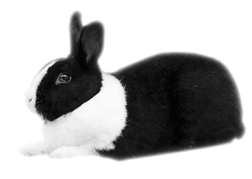 a Kind
a Kind